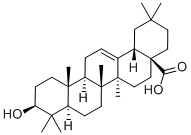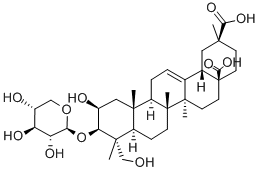PRODUCT Properties
| Melting point: | >300 °C (lit.) |
| alpha | D20 +83.3° (c = 0.6 in chloroform) |
| Boiling point: | 502.79°C (rough estimate) |
| Density | 1.0261 (rough estimate) |
| refractive index | 1.4940 (estimate) |
| storage temp. | 2-8°C |
| solubility | Chloroform (Very Slightly), DMSO (Slightly, Heated), Methanol (Slightly, Heated) |
| form | Solid |
| pka | 2.52(at 25℃) |
| color | light yellow |
| optical activity | +83.320 (c 0.6, CHCl3) |
| Merck | 14,6827 |
| InChIKey | NZQIXFRGWXNLSP-IDYUENATSA-N |
| LogP | 8.576 (est) |
| CAS DataBase Reference | 508-02-1(CAS DataBase Reference) |
| EPA Substance Registry System | Oleanolic acid (508-02-1) |
Description and Uses
Oleanolic acid or oleanic acid is a naturally occurring pentacyclic triterpenoid with the formula of C30H48O3. It was found in the non-glyceride fraction of olive pomace oil and is widely distributed in food and plants where it exists as a free acid or as an aglycone precursor for triterpenoid saponins, in which it can be linked to one or more sugar chains. It is biosynthesized from lupane. It can rearrange to the isomer, ursolic acid, or be oxidized to taraxasterol and amyrin. Oleanolic acid and its derivatives possess several promising pharmacological activities, such as hepatoprotective effects, and anti-inflammatory, antioxidant, or anticancer activities.
Oleanolic acid is a triterpenoid known for its anti-inflammatory properties, is commonly present in several medicinal plants. It can Inhibits secretory phospholipase A2 that is mainly used for the treatment of acute jaundiced hepatitis with remarkable efficacy, and also has good effect on chronic hepatitis.?
Safety
| Symbol(GHS) |  GHS07 |
| Signal word | Warning |
| Hazard statements | H315-H319-H335 |
| Precautionary statements | P261-P280a-P304+P340-P305+P351+P338-P405-P501a |
| Hazard Codes | Xi |
| Risk Statements | 36/37/38 |
| Safety Statements | 26-36-37/39-60-37 |
| WGK Germany | 2 |
| RTECS | RK0177965 |
| TSCA | Yes |
| HS Code | 29181990 |




